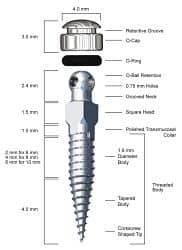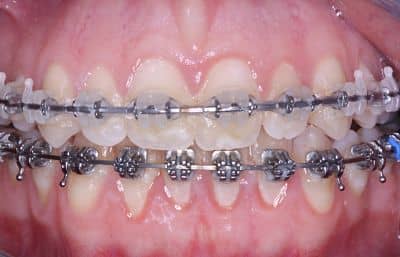By Mohammad R. Razavi, DDS, MSD, FRCD(C)

Miniscrews have been used with limited success to aid in molar intrusion in the past. Application of an intrusive force, away from the center of resistance, from miniscrews placed in the buccal bone in maxilla leads to a force couple and labial crown tipping, resulting in plunging of the palatal molar cusps and an increase in the anterior open bite. Placing miniscrews in the buccal posterior maxilla has also been associated with deviations in placement angle, impingement of the PDL space, and potential cementum contact.1 Furthermore, the posterior maxilla and maxillary tuberosity region have reduced cortical bone thickness, and provide inferior primary stability, which leads to premature loss of miniscrews.2 The palate, on the other hand, provides a site of thick, dense cortical bone that provides significant screw retention. The purpose of this article is to describe palatal anchorage using the UnitekTM TAD system (Figure 1) to control the vertical dimension and correct anterior open bites.

Prior to initial bonding, a modified transpalatal arch (TPA) as described by Cope (Figure 2) should be fabricated to be delivered at the time of appliance placement.3 The TPA should be designed such that the bar does not proximate the palatal tissue. Ideally, the TPA, made of .036 stainless steel wire, should be 5 mm away from the depth of the palate and 3 mm away from the palatal walls (Figure 3). The distal extensions must be soldered to the TPA such that they extend distally toward the second molars (Figure 4). For treatment efficiency, the TPA should be placed on the day of initial bonding, so that the leveling and aligning stage of treatment can progress with the molar bands in place.
Once initial leveling is complete and full-sized rectangular wires are in place, the miniscrew can be inserted into the palate to initiate maxillary molar intrusion. Local anesthesia is generally necessary to prepare the miniscrew placement site, since the palatal tissue is often too thick to achieve full anesthesia using compound topical anesthetics.
A 6-mm Unitek TAD System miniscrew should be placed at the level of the first molars, 1 to 2 mm lateral to the midpalatal suture. The placement angle must be 15º to 20º toward the anterior in order to resist the vertical forces applied during molar intrusion. The miniscrew can then be activated by securing two 3-mm nitinol coils to the head of the implant using a .010 stainless steel ligature, then attaching the other end of the spring to the distal extensions of the TPA (Figure 5). The Unitek TAD head design, with its .075-gauge cross-cut hole, allows for easy ligation of this ligature to the miniscrew.

Activation springs, along with the miniscrew and the TPA, can be removed once you have achieved sufficient increase in overbite. It is important to avoid extrusive mechanics, such as intermaxillary elastics, during the finishing phase of treatment. Such mechanics often extrude molars and increase the vertical dimension, and can result in the recurrence of the anterior open bite during the final finishing phase of treatment.

The palate has proven to be an effective site for miniscrew implant placement for movement of dentition in the anteroposterior dimension using indirect anchorage mechanics.4-6 It provides a site of thick, dense cortical bone that provides significant miniscrew stability.7 Furthermore, the bone is covered with ample keratinized tissue, making it resistant to tissue irritation and inflammation.
Other than the incisive foramen, the palate is also a site where there is limited potential for nerve and blood-vessel damage from miniscrew placement.7 The main advantage of the indirect anchorage system provided through a palatal miniscrew attached to a transpalatal arch is that it seldom requires any alterations in treatment mechanics. 

Mohammad R. Razavi, DDS, MSD, FRCD(C), maintains a private practice in Ottawa, Canada. He founded and directed the Skeletal Anchorage Clinic at Case Western Reserve. He has served as a member of the craniofacial team at the Cleveland Clinic Foundation, and has served as the orthodontist for the Cleveland Browns, and the Ottawa Senators. He is a diplomate of the American Board of Orthodontists and a Fellow of the Royal College of Dentists in Canada. and an ad hoc reviewer for the American Journal of Orthodontics and the Journal of Clinical Orthodontics. He has served as an advocate for 3M Unitek since 2007. He can be reached at [email protected].










References
1. Baumgaertel S, Razavi MR, Hans MG. Mini-implant anchorage for the orthodontic practitioner. Am J Orthod Dentofacial Orthop. 2008;133:621-627.
2. Park H, Lee Y, Jeong S, Kwon T. Density of the alveolar and basal bones of the maxilla and the mandible. Am J Orthod Dentofacial Orthop. 2008;133:30-37.
3. Cope JB. OrthoTADs: The Clinical Guide an Atlas. Dallas: Under Dog Media, 2007;361-367.
4. Razavi M. Indirect anchorage using the palate: A unique application of the Unitek Temporary Anchorage Device. Orthodontic Perspectives. 2010;17(2):6-9.
5. Razavi M. Applications and benefits of fixed anchorage in the palate. Orthodontic Perspectives. 2009;16(2):15-17.
6. Razavi M. MSIs, TPAs, and SLBs: Combining appliance systems can shorten treatment time and lengthen appointment intervals. Orthodontic Products. 2011;18(7):30-36.
7. Kang S, Lee S, Ahn S, Heo M, Kim T. Bone thickness of the palate for orthodontic mini-implant anchorage in adults. Am J Orthod Dentofacial Orthop. 2007;131:S74-80.








